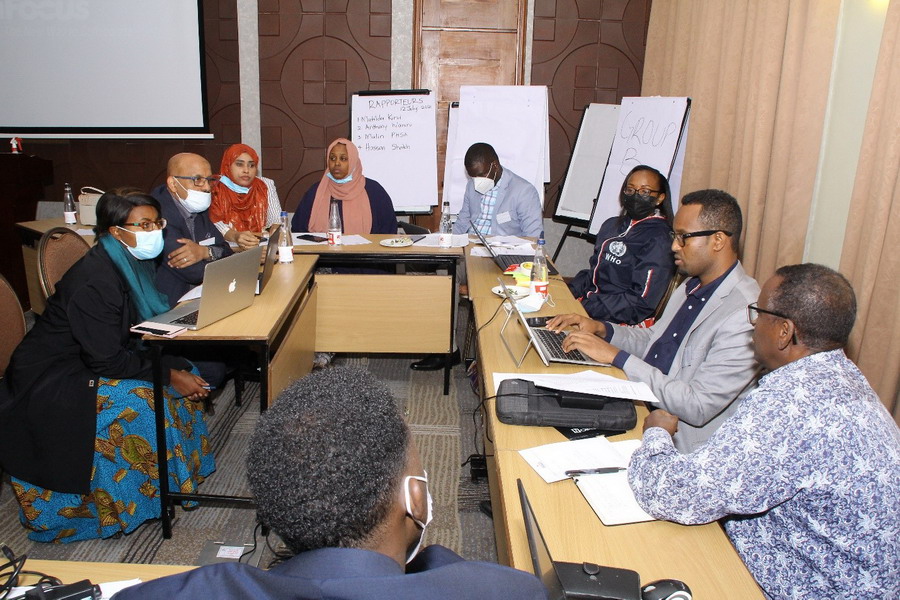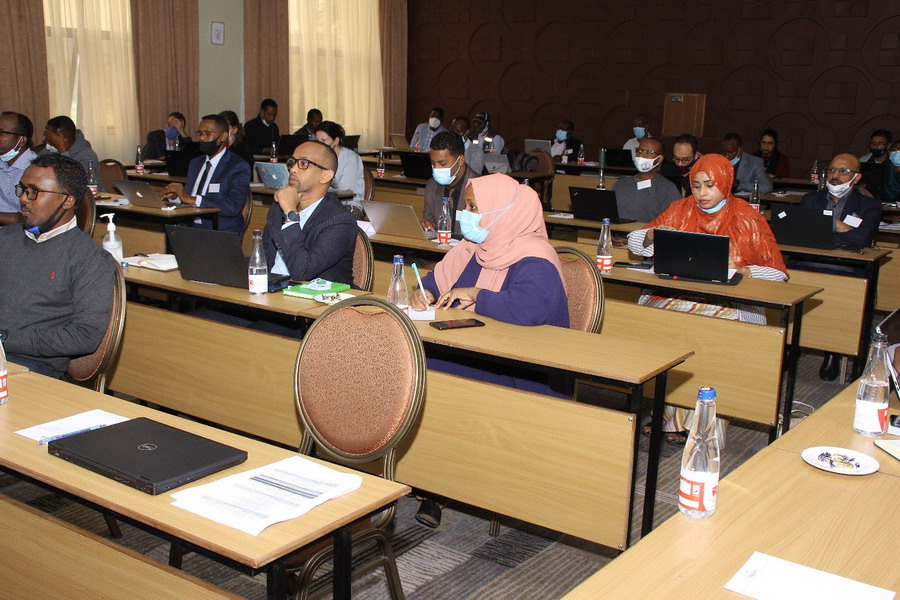 Participants at the IDSRS workshop formed groups to discuss topics such as the importance of focused disease surveillance in the context of the health challenges facing Somalia
Participants at the IDSRS workshop formed groups to discuss topics such as the importance of focused disease surveillance in the context of the health challenges facing Somalia
Why Somalia needed to implement the integrated disease surveillance and response strategy
As the COVID-19 pandemic has shown, the world is becoming a smaller place and travel across borders is becoming more accessible to growing populations, and the spread of diseases has become faster and more efficient. The pandemic has also shown that an outbreak in one country can quickly become a pandemic everywhere if the country’s capacity for early detection and effective response is weak. This has made it imperative for countries to prevent the spread of diseases both in-country and across borders, and for countries to act with speed and at scale each time an outbreak occurs in the interests of national and global public health.
Somalia has limited capacity to prevent, detect and respond to disease outbreaks and other acute public health events. This was demonstrated in 2018 by an International Health Regulations (IHR, 2005) assessment. The country’s current IHR capacity and health emergency preparedness index (a measure of IHR core capacity) is 31 out of 100 (at level 1 out of a maximum level 5), meaning that large gaps exist in the core capacities required to prevent, detect and comprehensively respond to public health threats.
Through sustained high-level efforts, led by the Somalia National Institute of Health of the Somalia Federal Ministry of Health, and supported by WHO, Somalia has adopted an integrated disease surveillance and response strategy (IDSRS) as the overall framework for strengthening disease surveillance, to step up efforts to prevent further spread of diseases and outbreaks.
First steps towards integrated surveillance and response: a workshop
As a critical step in the joint planning of IDSRS implementation in Somalia, the Federal Ministry of Health and National Institute of Health, with technical support from WHO, held a multi-stakeholder planning workshop for IDSRS implementation from 11 to 17 July 2021.
Over 60 participants participated in the workshop, including members of the National Institute of Health, Federal and State ministries of health and institutions of higher learning in the country, as well as staff from WHO headquarters, WHO Regional Office for the Eastern Mediterranean, WHO Somalia country office, the United Nations Children’s Fund (UNICEF), International Organization for Migration (IOM), United States Centers for Disease Control and Prevention (US CDC), and the Public Health Institute Sweden. Representatives from the ministries of health of Kenya, Nigeria, Tanzania (United Republic of) and Uganda also participated.
Objectives of the ISDR workshop
The objectives of the workshop included to sensitize the high-level officials from the National Institute of Health and Federal Ministry of Health on health security, public health emergency operation centres (PHEOCs) and the IDSRS. The workshop also aimed to consult on the updating of the country’s list of priority hazards to guide the drafting of the country’s all-hazard preparedness and response plans and contingency plans for the highest-ranking priority hazards. By bringing together stakeholders, the workshop worked to generate an overall consensus and agreement on the next steps towards the establishment of the IDSRS and PHEOCs in Somalia.
To engage participants, the workshop used a blend of physical and online PowerPoint presentations, groupwork sessions, tabletop exercises, and plenary presentations and discussions. Participants from Kenya, Uganda, Nigeria, Tanzania (United Republic of), Public Health Institute Sweden and US CDC shared their experiences to enrich the exchange of information.
Outcomes and outputs of the workshop
Participants gained knowledge on health security, health emergency concepts, and the main hazards and risk profile of Somalia, as well as on public health emergency operations, including plans, policies, procedures and risk assessment. Through technical groups, participants identified next steps and timelines for establishment of the IDSRS and PHEOCs.
Additionally, groups discussed the response to common challenges facing Somalia, such as cholera, flash floods, drought and armed conflict.
The key discussion points and themes for the IDSRS included optimizing good leadership and accountability, ensuring functional IDSRS design and country ownership, conducting high-level advocacy, ensuring constant availability of skilled health workers, institutionalizing IDSRS and PHEOC training into local institutions of higher learning, scaling up event-based surveillance and community-based surveillance, rolling out electronic IDSRS, providing feedback and information-sharing, and integrating the IDSRS into the broader national health information system.
Next steps towards creating a robust and effective IDSRS
To move the agenda forward, the National Institute of Health and Federal Ministry of Health, with support from WHO and other partners, will develop a costed three-year IDSRS operational plan, IDSRS technical guidelines and training materials.
A PHEOC roadmap and PHEOC plans, such as the all-hazards preparedness and response plan, and national-level and state-level hazard-specific contingency plans, will be developed in due course. To enable the States to develop focused preparedness and response plans, an assessment of hazards will be conducted at the subnational level.
The team working on the IDSRS has already finalized the national risk profile report and the handbook for PHEOC operations. Furthermore, the Federal Ministry of Health will identify and appoint PHEOC staff at national and state levels who will be trained with the support of WHO, and will procure and install the basic equipment required for PHEOC operations to ensure they are functional and efficient.
All these steps will ensure Somalia has in place a robust, effective and sensitive disease surveillance system that can nip in the bud outbreaks before they become a large threat to Somalia and the world.
The establishment of an IDSRS will go a long way towards safeguarding national health security through improvement in surveillance, detection and response to emerging and re-emerging infectious diseases, including all health threats which have the potential to cross borders and become a public health emergency of international concern.
WHO, with funding support from Canada through ACT-A Health Systems Connector, is implementing the IDSRS as part of health system building in Somalia.
 The IDSRS workshop provided a platform for key partners to join together to establish a functional and extensive disease surveillance system in Somalia
The IDSRS workshop provided a platform for key partners to join together to establish a functional and extensive disease surveillance system in Somalia


